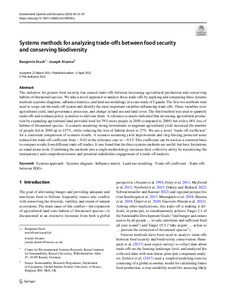Systems methods for analyzing trade‑offs between food security and conserving biodiversity
| dc.date.accessioned | 2024-03-11T10:14:46Z | |
| dc.date.available | 2024-03-11T10:14:46Z | |
| dc.date.issued | 2023-04-15 | |
| dc.identifier | doi:10.17170/kobra-202403089747 | |
| dc.identifier.uri | http://hdl.handle.net/123456789/15546 | |
| dc.description.sponsorship | Gefördert im Rahmen des Projekts DEAL | |
| dc.language.iso | eng | |
| dc.rights | Namensnennung 4.0 International | * |
| dc.rights.uri | http://creativecommons.org/licenses/by/4.0/ | * |
| dc.subject | Systems approach | eng |
| dc.subject | Systems diagram | eng |
| dc.subject | Influence matrix | eng |
| dc.subject | Land use modelling | e |
| dc.subject | Trade-off coeffictient | eng |
| dc.subject | Trade offs between SDGs | eng |
| dc.subject.ddc | 360 | |
| dc.subject.ddc | 630 | |
| dc.title | Systems methods for analyzing trade‑offs between food security and conserving biodiversity | eng |
| dc.type | Aufsatz | |
| dcterms.abstract | The endeavor for greater food security has caused trade-offs between increasing agricultural production and conserving habitat of threatened species. We take a novel approach to analyze these trade-offs by applying and comparing three systems methods (systems diagrams, influence matrices, and land use modeling) in a case study of Uganda. The first two methods were used to scope out the trade-off system and identify the most important variables influencing trade-offs. These variables were agricultural yield, land governance processes, and change in land use and land cover. The third method was used to quantify trade-offs and evaluate policy scenarios to alleviate them. A reference scenario indicated that increasing agricultural production by expanding agricultural land provided food for 79% more people in 2050 (compared to 2005) but with a 48% loss of habitat of threatened species. A scenario assuming strong investments to augment agricultural yield increased the number of people fed in 2050 up to 157%, while reducing the loss of habitat down to 27%. We use a novel “trade-off coefficient” for a consistent comparison of scenario results. A scenario assuming yield improvement and ring-fencing protected areas reduced the trade-off coefficient from − 0.62 in the reference case to − 0.15. This coefficient can be used as a common basis to compare results from different trade-off studies. It was found that the three systems methods are useful, but have limitations as stand-alone tools. Combining the methods into a single methodology increases their collective utility by maximizing the transparency and comprehensiveness and potential stakeholder engagement of a trade-off analysis. | eng |
| dcterms.accessRights | open access | |
| dcterms.creator | Stuch, Benjamin | |
| dcterms.creator | Alcamo, Joseph | |
| dc.relation.doi | doi:10.1007/s10669-023-09909-y | |
| dc.subject.swd | Ernährungssicherheit | ger |
| dc.subject.swd | Nahrungsmittel | ger |
| dc.subject.swd | Sicherheit | ger |
| dc.subject.swd | Biodiversität | ger |
| dc.subject.swd | Landnutzung | ger |
| dc.subject.swd | Modellierung | ger |
| dc.type.version | publishedVersion | |
| dcterms.source.identifier | eissn:2194-5403 | |
| dcterms.source.issue | Issue 1 | |
| dcterms.source.journal | Environment Systems and Decisions | eng |
| dcterms.source.pageinfo | 16 - 29 | |
| dcterms.source.volume | Volume 44 | |
| kup.iskup | false |
Files in this item
This item appears in the following Collection(s)
-
Artikel [1109]


